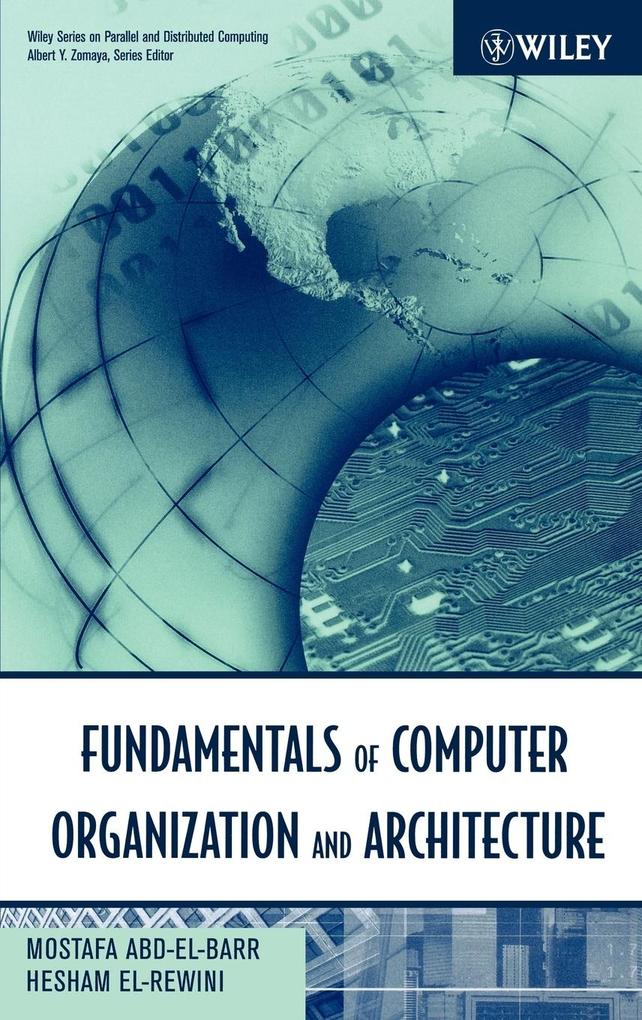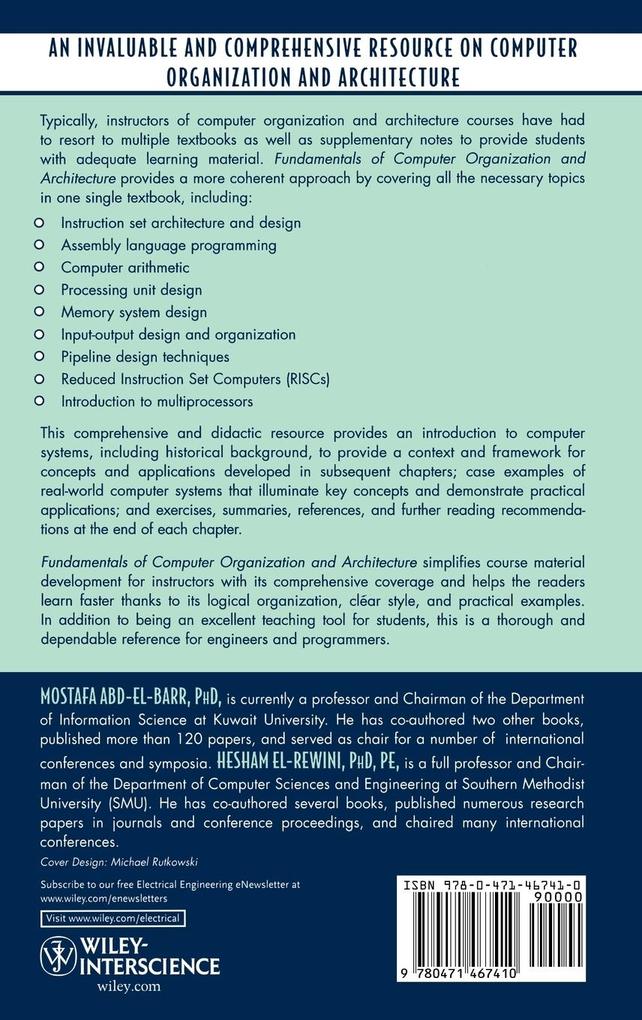
Zustellung: Mo, 28.07. - Fr, 01.08.
Versand in 2 Wochen
VersandkostenfreiComputer architecture deals with the physical configuration, logical structure, formats, protocols, and operational sequences for processing data, controlling the configuration, and controlling the operations over a computer. It also encompasses word lengths, instruction codes, and the interrelationships among the main parts of a computer or group of computers.
An invaluable and comprehensive resource on computer organization and architecture Typically, instructors of computer organization and architecture courses have had to resort to multiple textbooks as well as supplementary notes to provide students with adequate learning material. Fundamentals of Computer Organization and Architecture provides a more coherent approach by covering all the necessary topics in one single textbook, including:
Fundamentals of Computer Organization and Architecture simplifies course material development for instructors with its comprehensive coverage and helps the readers learn faster thanks to its logical organization, clear style, and practical examples. In addition to being an excellent teaching tool for students, this is a thorough and dependable reference for engineers and programmers.
- Instruction set architecture and design
- Assembly language programming
- Computer arithmetic
- Processing unit design
- Memory system design
- Input-output design and organization
- Pipeline design techniques
- Reduced Instruction Set Computers (RISCs)
- Introduction to multiprocessors
Fundamentals of Computer Organization and Architecture simplifies course material development for instructors with its comprehensive coverage and helps the readers learn faster thanks to its logical organization, clear style, and practical examples. In addition to being an excellent teaching tool for students, this is a thorough and dependable reference for engineers and programmers.
Inhaltsverzeichnis
Preface. 1. Introduction to Computer Systems.
1. 1. Historical Background.
1. 2. Architectural Development & Styles.
1. 3. Technological Development.
1. 4. Performance Measures.
1. 5. Summary.
Exercises.
References and Further Reading.
2. Instruction Set Architecture & Design.
2. 1. Memory Locations and Operations.
2. 2. Addressing Modes.
2. 3. Instruction Types.
2. 4. Programming Examples.
2. 5. Summary.
Exercises.
References and Further Reading.
3. Assembly Language Programming.
3. 1. A Simple Machine.
3. 2. Instructions Mnemonics and Syntax.
3. 3. Assembler Directives and Commands.
3. 4. Assembly and Execution of Programs.
3. 5. Example: The X 86 Family.
3. 6. Summary.
Exercises.
References and Further Reading.
4. Computer Arithmetic.
4. 1. Number Systems.
4. 2. Integer Arithmetic.
4. 3. Floating Point Arithmetic.
4. 4. Summary.
Exercises.
References and Further Readings.
5. Processing Unit Design.
5. 1. CPU Basics.
5. 2. Register Set.
5. 3. Data Path.
5. 4. The CPU Instruction Cycle.
5. 5. Control Unit.
5. 6. Summary.
Exercises.
References.
6. Memory System Design I.
6. 1. Basic Concepts.
6. 2. Cache Memory.
6. 3. Summary.
Exercises.
References and Further Readings.
7. Memory System Design II.
7. 1. Main Memory.
7. 2. Virtual Memory.
7. 3. Read-Only Memory.
7. 4. Summary.
Exercises.
References and Further Readings.
8. Input-Output Design and Organization.
8. 1. Basic Concepts.
8. 2. Programmed I/O.
8. 3. Interrupt-Driven I/O.
8. 4. Direct Memory Access (DMA).
8. 5. Busses.
8. 6. Input-Output Interfaces.
8. 7. Summary.
Exercises.
References and Further Readings.
9. Pipelining Design Techniques.
9. 1. General Concepts.
9. 2. Instruction Pipeline.
9. 3. Arithmetic pipeline.
9. 4. Summary.
Exercises.
References and Further Reading.
10. Reduced Instruction Set Computers (RISCs).
10. 1. RISC/CISC Evolution Cycle.
10. 2. RISCs Design Principles.
10. 3. Overlapped Register Windows.
10. 4. RISCs Versus CISCs.
10. 5. Pioneer (University) RISC Machines.
10. 6. Example of Advanced RISC Machines.
10. 7. Summary.
Exercises.
References and Further Readings.
11. Introduction to Multiprocessors.
11. 1. Introduction.
11. 2. Classification of Computer Architectures.
11. 3. SIMD Schemes.
11. 4. MIMD Schemes.
11. 5. Interconnection Networks.
11. 6. Analysis and Performance Metrics.
11. 7. Summary.
Exercises.
References and Further Readings.
Index.
1. 1. Historical Background.
1. 2. Architectural Development & Styles.
1. 3. Technological Development.
1. 4. Performance Measures.
1. 5. Summary.
Exercises.
References and Further Reading.
2. Instruction Set Architecture & Design.
2. 1. Memory Locations and Operations.
2. 2. Addressing Modes.
2. 3. Instruction Types.
2. 4. Programming Examples.
2. 5. Summary.
Exercises.
References and Further Reading.
3. Assembly Language Programming.
3. 1. A Simple Machine.
3. 2. Instructions Mnemonics and Syntax.
3. 3. Assembler Directives and Commands.
3. 4. Assembly and Execution of Programs.
3. 5. Example: The X 86 Family.
3. 6. Summary.
Exercises.
References and Further Reading.
4. Computer Arithmetic.
4. 1. Number Systems.
4. 2. Integer Arithmetic.
4. 3. Floating Point Arithmetic.
4. 4. Summary.
Exercises.
References and Further Readings.
5. Processing Unit Design.
5. 1. CPU Basics.
5. 2. Register Set.
5. 3. Data Path.
5. 4. The CPU Instruction Cycle.
5. 5. Control Unit.
5. 6. Summary.
Exercises.
References.
6. Memory System Design I.
6. 1. Basic Concepts.
6. 2. Cache Memory.
6. 3. Summary.
Exercises.
References and Further Readings.
7. Memory System Design II.
7. 1. Main Memory.
7. 2. Virtual Memory.
7. 3. Read-Only Memory.
7. 4. Summary.
Exercises.
References and Further Readings.
8. Input-Output Design and Organization.
8. 1. Basic Concepts.
8. 2. Programmed I/O.
8. 3. Interrupt-Driven I/O.
8. 4. Direct Memory Access (DMA).
8. 5. Busses.
8. 6. Input-Output Interfaces.
8. 7. Summary.
Exercises.
References and Further Readings.
9. Pipelining Design Techniques.
9. 1. General Concepts.
9. 2. Instruction Pipeline.
9. 3. Arithmetic pipeline.
9. 4. Summary.
Exercises.
References and Further Reading.
10. Reduced Instruction Set Computers (RISCs).
10. 1. RISC/CISC Evolution Cycle.
10. 2. RISCs Design Principles.
10. 3. Overlapped Register Windows.
10. 4. RISCs Versus CISCs.
10. 5. Pioneer (University) RISC Machines.
10. 6. Example of Advanced RISC Machines.
10. 7. Summary.
Exercises.
References and Further Readings.
11. Introduction to Multiprocessors.
11. 1. Introduction.
11. 2. Classification of Computer Architectures.
11. 3. SIMD Schemes.
11. 4. MIMD Schemes.
11. 5. Interconnection Networks.
11. 6. Analysis and Performance Metrics.
11. 7. Summary.
Exercises.
References and Further Readings.
Index.
Produktdetails
Erscheinungsdatum
03. Dezember 2004
Sprache
englisch
Seitenanzahl
288
Autor/Autorin
Hesham El-Rewini, Mostafa Abd-El-Barr
Verlag/Hersteller
Produktart
gebunden
Gewicht
607 g
Größe (L/B/H)
240/161/20 mm
ISBN
9780471467410
Pressestimmen
"The book takes its value from being very well organized, concise, and clear." ( CHOICE , July 2005)
"In addition to being an excellent tool for students, this is a thorough and dependable reference for engineers and programmers." ( International Journal of General Systems , June 2005)
"...a textbook that is useful as an introduction to computer organization fundamentals..." ( Computing Reviews.com , March 10, 2005)
"In addition to being an excellent tool for students, this is a thorough and dependable reference for engineers and programmers." ( International Journal of General Systems , June 2005)
"...a textbook that is useful as an introduction to computer organization fundamentals..." ( Computing Reviews.com , March 10, 2005)
Bewertungen
0 Bewertungen
Es wurden noch keine Bewertungen abgegeben. Schreiben Sie die erste Bewertung zu "Fundamentals of Computer Organization and Architecture" und helfen Sie damit anderen bei der Kaufentscheidung.









